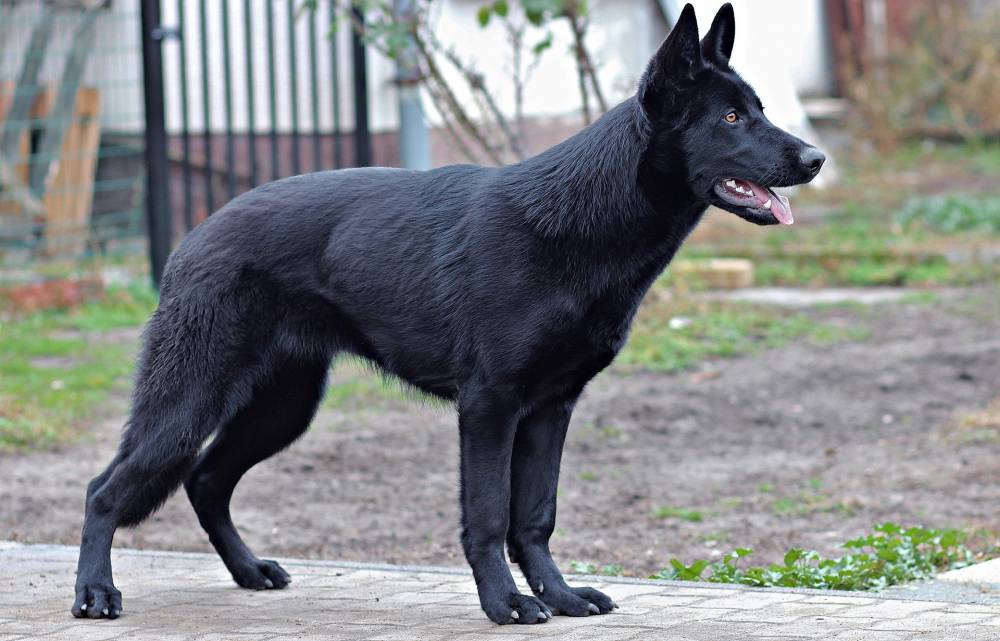Quick Navigation
Dogs are amazing creatures. They love their owners unconditionally and are always there for them.
However, sometimes dogs get sick and become unable to move.
If you notice your dog standing and not moving, you should immediately call your vet.
In case your pet has been injured, he needs immediate medical attention.

Otherwise, here are some possible reasons why your dog might stand and not move.
Possible Reasons Why Your Dog Is Standing and Not Moving
1. Intervertebral Disk Disease (IVDD)
If your dog just stands and cannot move an inch, it could be a case of Intervertebral disk disease (IVDD).
Your vet may describe this as a ruptured, slipped, bulging, or herniated disk in your dog’s back or neck.
This condition can cause the dog to become stiff and unable to move.
The symptoms include pain in the back legs, inability to walk normally, and difficulty urinating.
The most common cause of IVDD is over-exercise.
Your dog may have been running too much, jumping too high, pulling too hard on his leash, or playing with other dogs.
It makes the discs wear out and tear apart.
If your dog has IVDD, he will need to rest and avoid strenuous activities.
In addition, he needs to take anti-inflammatory drugs such as Rimadyl and Carprofen.
2. Dog Paralysis
Paralysis is a neurological disorder that can sometimes make dogs stand still and not move.
It happens when the central nervous system’s ability to coordinate the body’s movements is wholly lost.
It mainly affects the hind legs, although it can also affect other parts of the body, including the facial muscles, the front legs, or the muscles that control defecation and urination.
For any living thing to move, the brain, spine, nerves, and muscles work together.
However, if the nerves carrying messages between the brain and the body are damaged, complex paths of communication breakdown cause paralysis.
- Inability to move back legs or all four legs
- Dragging rear legs when walking
- Signs of pain in the neck, spine, or legs
- Inability to control urination or defecation
- Constipation
- Inability to urinate at all
- Inability to blink
- Discharge or irritation of the eyes
If you see any of the following symptoms on your dog, run to the vet right away.
3. Osteoarthritis
Osteoarthritis is another possible reason why your dog stands and is unable to move.
It is the most common form of arthritis in dogs, affecting approximately a quarter of the population.
QA is characterized by wearing off the joint cartilage, thickening the joint capsule, and new bone formation around the joint, leading to pain and limb dysfunction.
Osteoarthritis usually occurs in older dogs, but it can occur at any age.
It is more likely to affect large-breed dogs than small ones. Other causes include obesity, gender, diet, and excesses.
Symptoms include stiffness, lameness, pain when walking, and aggression, so if your dog just stands and is unable to move, it could be a case of osteoarthritis, and you should visit a vet.
4. Hip Dysplasia
Another possible reason why your dog stands and doesn’t move is hip dysplasia.
Hip dysplasia is a genetic disorder that primarily affects larger breeds of dogs, although it can also affect smaller ones.
It is characterized by the hip joint becoming misaligned. When this happens, your dog cannot walk properly.
Some of the contributing factors include genetics, excessive growth rate, some exercises, weight gain, and improper nutrition.
Your vet will conduct an x-ray examination to determine if your dog has hip dysplasia.
Treatment includes surgery to correct the problem.

5. Rheumatoid Arthritis
Rheumatoid arthritis is a disorder that affects the joints in your dog’s body.
Like other types of arthritis, there is lameness, but rheumatoid arthritis specifically degrades the cartilage.
Symptoms include:
- Lameness
- Loss of movement
- Stiffness
- Fever
- Lack of appetite
- Enlarged lymph nodes
- Limb atrophy
- Multiple joint pain
- Joint swelling
6. Canine Cognitive Dysfunction Syndrome
One possible cause of your dog’s standing and can’t move an inch is Cognitive dysfunction syndrome.
This term describes a group of symptoms that affect a dog’s ability to think clearly.
It is most commonly familiar in older dogs. The symptoms include:
- Difficulty remembering things
- Lack of focus
- Disorientation
- Confusion
- Poor judgment
- Aggression
There is no cure for CDS. However, some treatments can improve your dog’s quality of life.
These include:
- Medication
- Exercise
- Nutrition
- Environmental enrichment
If you notice any of the above symptoms in your dog, take him to the veterinarian immediately.
7. Cancer
The last possible reason why your dog stands and can’t move is cancer.
Many types of cancers can affect dogs, including skin, breast, lung, prostate, colon, liver, kidney, blood, bone, brain, etc.
Cancer is an illness where cells grow out of control and spread throughout the body.
Your dog may have one or multiple tumors.
Other symptoms include:
- Unusual behavior
- Weight loss
- Coughing up blood
- Vomiting
- Diarrhea
- Weakness
- Fever
- Depression
If your dog is unable to move and shows the above symptoms, consult your vet immediately.
8. Degenerative Myelopathy
It is a disease that affects the spinal cord and peripheral nerves.
The most common clinical signs are trouble walking, ataxia, and proprioceptive deficits.
Other symptoms may include urinary incontinence, dysphagia, dyspnea, decreased appetite, weight loss, and behavioral changes.
DM has been reported in all breeds, but it is more commonly seen in small-breed dogs.
It is an age-related disorder that can be diagnosed with imaging techniques such as MRI.
Suppose your dog is unable to work and accompanied by the above signs.
In that case, it is best to take your dog to a neurologist or veterinary specialist who will perform a neurological examination on him.
9. Fractures
Dogs are very playful and may fall during their playtime which is why they are most likely to suffer a broken bone due to an impact.
Puppies, small dogs, older dogs, and dogs with conditions are very prone also to broken bones.
A fracture is a break in a bone. Bones are living tissues that keep your organs healthy.
A broken bone can cause pain and make your dog have difficulties walking.
And it might limp or use one leg or not walk completely.
Other signs of fracture include; swelling of the affected area guarding the injury, whining, not playing, and lack of appetite.
If your puppy displays the mentioned signs, it is important to seek veterinarians’ help or the emergency clinic immediately, as things can worsen as time passes.
10. Other Causes
Some other reasons why your dog might stand and not move include:
- Pregnancy
- Your dog is recovering from surgery
- Your dog may be bored or lonely
- It could be just for attention
- Muscle strain
- Scared of something. This happens mostly in puppies, and it’s just one of the periods in their life. You may also notice this in adult dogs who just moved to a new and unfamiliar environment(they are anxious especially when they have a history of trauma)
Home Remedies for Dogs’ Inability to Walk
Home remedies for dogs with paralysis can range from simple things like giving your dog plenty of rest to more complicated treatments like acupuncture.
There are also products like the Doggy Pillow that can provide comfort for your pet.
You should take note of your dog’s behavior and appearance so that you can tell if something is wrong.
If the cause is anxiety or fear, you can help them build their confidence.
First, you need to determine the source so you can help them build resistance.
You can also use your voice and command the dog to redirect his attention and offer treats.
If your dog seems passive, weak, or uncoordinated, it could mean that he is suffering from a medical condition.
It’s also best to relocate your dog to a safe, indoor location whenever you notice his inability to move.
You can ask your vet about what to look out for.
Final Thought
As you can see, there are so many causes of your dog standing and not moving.
So, make sure you check all the possibilities before taking action.
It is important to remember that your dog’s health is essential to you, and it is best to seek professional advice whenever possible.

Zoey is a long-time pet owner and animal rights advocate, a vital part of Purrfect n’ Pawesome. She shares her unique experiences and learnings with her readers to enhance their understanding of pet behavior and nutrition. Along with being an active pet writer, she volunteers at multiple animal shelters, rescue centres with some bespokenly awesome pets.
Zoey has a lot to share when raising the pets and spending life being their true friends. She has a quite pampered Persian cat and a Ragdoll, whom she loves the most. Readout her blogs to know more about being a responsible parent to your beloved pets.
“I love to be around cats and dogs; that’s my passion and my trick to get away from all the negativity and soaking in unconditional love and affection. Being attached to this platform gives me the reason to be vocal about pet love, care, and nurturing. Although I am not an expert or veterinarian by any means, I have a lot of experience and learnings to share with my fellow readers.”
